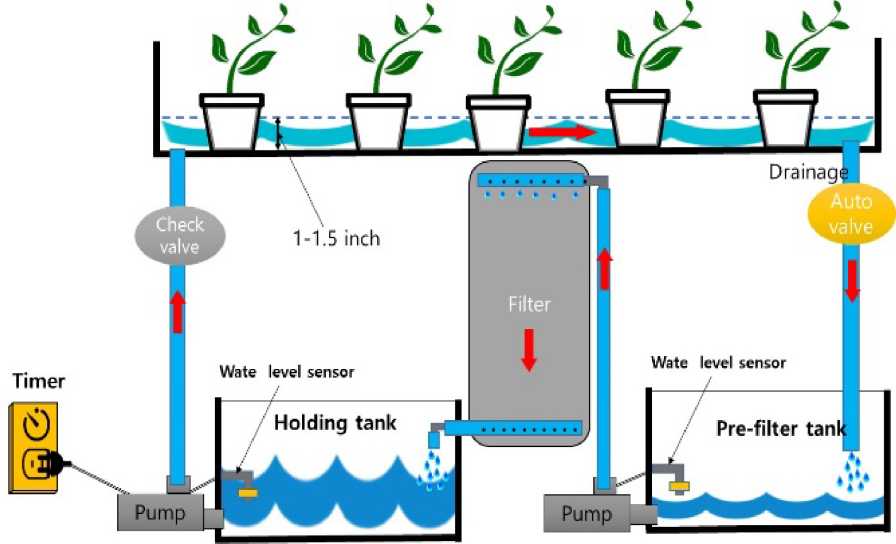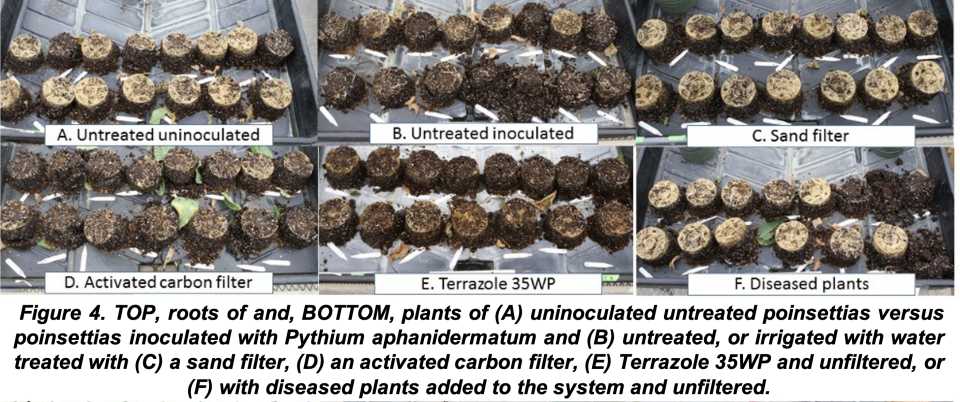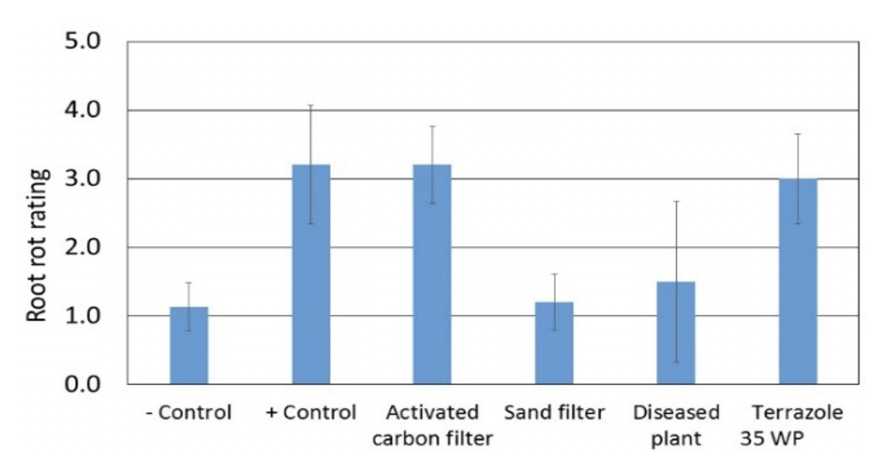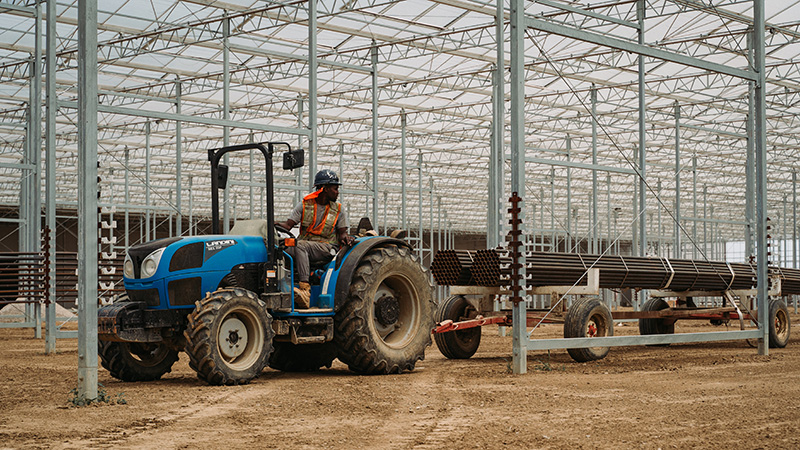Tips to Manage Pythium Risk in Irrigation Water
Water mold pathogens like Pythium are an insidious problem in greenhouses. They are able to release spores that swim in water (called zoospores) via the motion of their flagella. Zoospores can easily spread disease to plants, where they shed their flagella and encyst on and infect the plant.
Water mold pathogens are especially a threat to crops that are irrigated with recirculating water. Pythium spp. water molds threaten the production of highly susceptible crops such as poinsettia, snapdragon, and geranium. They can cause seedling damping-off and stem and root rot on floriculture crops and are difficult to control. Plants can be infected and not show symptoms until the disease is too advanced to respond to treatment.
There are few fungicides effective against Pythium spp., and development of resistance in the Pythium pathogen to effective fungicides is a primary concern. Water molds may be introduced into a greenhouse via irrigation water or on plug trays and prefinished plants. If an infected plant is present in a flat, the disease may be spread plant to plant following watering as the zoospores of the water mold moves in the water. Zoospores may also enter the recirculating nutrient solution and be spread throughout the greenhouse.
A few years ago, Michigan State University researchers visited with Michigan greenhouses to engage floriculture growers in an American Floral Endowment-funded project. Growers reported disease outbreaks, irrigation tanks requiring frequent cleaning, and inability to reuse water due to problems with water molds.
Water filtration is a potential low-cost solution to managing water molds that may be as effective as costly ultraviolet filtration and ozone treatments. Recycling irrigation water is beneficial from both environmental and economical perspectives but can increase the severity of water mold plant disease problems in the greenhouse.
The objectives of the project were to: 1) Test novel filter media for zoospore removal in laboratory column experiments, and 2) Test novel filter media in small-scale filter units in a greenhouse environment to characterize the effects of filtration on zoospore infection of susceptible host plants.

Six self-contained irrigation systems were constructed and used to evaluate the effect of filtration on infection of poinsettia and acorn squash by zoospores. Photos and charts: Michigan State University
Materials and Methods
Test novel filter media for zoospore removal in laboratory column experiments. Laboratory column experiments were conducted to identify promising filter media that could be used in greenhouse filtration tests. Sand coated with nano-sized iron oxide particles and uncoated sand were packed into glass columns. The iron oxide particles carry positive surface charge at acidic or neutral pH. Spores of plant pathogens are usually negatively charged, and the positively charged media surface would attract pathogen spores and remove them from the water. In preliminary tests, we used another water mold that we have experience with, Phyophthora capsici, to develop the techniques needed for research with Pythium spp. We investigated the removal of Phytophthora zoospores in saturated columns packed with iron-oxide-coated sand (IOCS) or uncoated sand in at neutral pH (7.7) or acidic pH (4.0). We also examined the difference in filtering out mobile zoospores versus encysted zoospores.
Test novel filter media in small-scale filter units in a greenhouse environment to characterize the effect of filtration on zoospore infection of susceptible host plants. Six self-contained irrigation systems were constructed and used to evaluate the effect of filtration on infection of poinsettia and acorn squash by zoospores. The systems consisted of an ebb-and-flow bench connected to a filter via two hydraulic pumps and two 34-gallon holding tanks. Water was pumped through the filter, into the post-filter holding tank, onto the bench, and back into the pre-filter holding tank automatically on a predetermined schedule.
The filtration units consisted of capped 6-inch PVC columns filled with either (a) sand, (b) a novel iron oxide coated porous media (IOCM), or (c) activated carbon. The design replicated, at research scale in a research greenhouse, a method of filtration that could be adapted for use in commercial greenhouses.
We first tested a known crop/pathogen system which would guarantee results: squash/P. capsici. Twelve-day-old acorn squash seedlings grown in 5-inch greenhouse pots in peat potting mix were placed onto the benchtop. A 500 mL of a suspension of zoospore in water (400,000 zoospores/mL) was added to the pre-filter holding reservoir, resulting in a concentration of 1,700 zoospores/mL. The squash plants were irrigated twice daily for 10 minutes to prevent oversaturation of the growing media. Water samples were taken every four days from the holding tank, plated onto agar media, and spores were counted after 2 days. Weights of the plants when fresh and after drying were recorded. We completed two trials using sand and two filtering media developed by MetaMateria, granularIOCM, or monolith IOCM.
Two poinsettia/Pythium trials were completed testing removal of P. aphanidermatum zoospores by the filtration system using ‘Early Prestige Red’ poinsettia as the host plant. In these trials, 15 plants in 6-inch pots were placed onto each of six benches. A sand filter and an activated carbon (AC) filter were tested. Two additional unfiltered treatments included Terrazole 35WP (etridiazole) dosed into the water tank at the labeled rate (250 mg/L), and a diseased plant treatment that had three infected plants placed onto the bench to observe an alternative mode of disease spread. P. aphanidermatum zoospores were added to the pre-filter tanks (water pH at 7.3-8.8) and were passed through the filters and irrigated onto the-ebb-and-flow benchtops to initiate the experiment. Plants were irrigated twice daily for 15 minutes to increase disease pressure. The two trials were concluded after 69 and 78 days, respectively.

Rot on roots of poinsettias in the six experimental treatments of uninoculated irrigation water treatment without filtration or Pythium (– Control, A), inoculated irrigation water treatment without filtration or fungicide (+ Control, B), inoculated irrigation water treatment with a sand filter (C), inoculated irrigation water treatment with an activated carbon (AC) filter (D), inoculated irrigation water treatment with the fungicide (Terrazole 35WP) application without filters (E), and diseased plants added to the system without fungicide or filters (F).
Results
Test novel filter media for zoospore removal in laboratory column experiments. Results showed that the zoospores were readily attached to the surface of the IOCS filter media. Significantly more encysted zoospores were removed by the IOCS filter media than by uncoated sand. Mobile zoospores were more readily transported through the system than encysted zoospores, thus posing a greater dispersal and infection risk.
Test novel filter media in small-scale filter units in a greenhouse environment to characterize the effect of filtration on zoospore infection of susceptible host plants. In the squash/Phytophthora trials, the IOCM performed significantly better (P<0.01) than the sand column and untreated inoculated (+ control) plants in both trials according to data that were recorded as plant fresh weight. The concentration of zoospores in both the IOCM and sand media holding tanks were reduced after the initial filtration to less than 90% of the control and remained low for the duration of the experiment compared to the inoculated control. The sand media contained 83% fewer zoospores than the control, while the IOCM contained no zoospores in solution at the end of the trial.
In the poinsettia/Pythium trials, the inoculated untreated poinsettias displayed severe root rot and stunting (Figures 2 and 3). The condition of the roots in each pot was evaluated and given a rating: 1 = no symptom; 2 = mild root rot (<1/3 roots affected); 3 = intermediate root rot (1/3-2/3 roots affected); 4 = severe root rot (>2/3 roots affected); 5=severe root and crown rot; 6=dead roots. The sand filter was effective in preventing root rots, while the activated carbon filter was not effective.

Poinsettias in the activated carbon filter treatment were stunted with yellowed foliage and the lowest horticulturally desirable appearance, while those in the sand filter were very similar to the uninoculated untreated plants. The lowest foliar fresh weight (P<0.05) was observed for the activated carbon filter treatment, while the sand filter, Terrazole treatment, and ‘diseased plant’ treatment had higher (P<0.05) foliar fresh weight than the inoculated control treatment.
Conclusions
The results suggest that removing zoospores through filtration is affected by whether the zoospores have flagella or are encysted, and the type of filter media used. Filtration has promise for use in a greenhouse setting, but activated carbon should be discouraged despite its popularity in water treatment processes, unless nutrients are supplied separately from irrigation water. However, more research is needed. These results have been published in Environmental Science & Technology, HortTechnology, and Acta Horticulture.

Sand filters were effective in preventing root rots, while the activated carbon filter was not effective. (- Control = untreated uninoculated; + control = untreated inoculated).
Industry Impact
Projected impacts to the industry include the following: 1) Development of a reliable filtration system may provide the means of removing water mold plant pathogens from greenhouse irrigation water; 2) Producers may be able to reduce fungicide applications targeted for water mold pathogens; and 3) As a result of improved floriculture plant quality, producers will retain and expand their markets.









